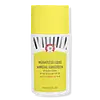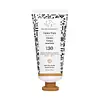What's inside
What's inside
 Key Ingredients
Key Ingredients

 Benefits
Benefits

 Concerns
Concerns

 Ingredients Side-by-side
Ingredients Side-by-side

Zinc Oxide 22%
Cosmetic ColorantEthylhexyl Olivate
Skin ConditioningIsododecane
EmollientCoconut Alkanes
EmollientWater
Skin ConditioningAluminum Starch Octenylsuccinate
AbsorbentCaprylic/Capric Triglyceride
MaskingButylene Glycol
HumectantMica
Cosmetic ColorantPolyglyceryl-6 Polyricinoleate
EmulsifyingJojoba Esters
EmollientCellulose
AbsorbentStearalkonium Hectorite
Gel FormingSodium Chloride
MaskingSqualane
EmollientPolyglyceryl-3 Diisostearate
EmulsifyingPolyglyceryl-3 Polyricinoleate
EmulsifyingIron Oxides
Phenoxyethanol
PreservativeTocopheryl Acetate
AntioxidantCoco-Caprylate/Caprate
EmollientTrihydroxystearin
Skin ConditioningCaprylyl Glycol
EmollientPolyhydroxystearic Acid
EmulsifyingGlycerin
HumectantTrisodium Ethylenediamine Disuccinate
Propanediol
SolventSorbic Acid
PreservativeTitanium Dioxide
Cosmetic ColorantSilica
AbrasiveGlycyrrhiza Glabra Root Extract
BleachingCamellia Sinensis Leaf Extract
AntimicrobialAlumina
AbrasiveTocopherol
AntioxidantChrysanthemum Parthenium Extract
Skin ConditioningZinc Oxide 22%, Ethylhexyl Olivate, Isododecane, Coconut Alkanes, Water, Aluminum Starch Octenylsuccinate, Caprylic/Capric Triglyceride, Butylene Glycol, Mica, Polyglyceryl-6 Polyricinoleate, Jojoba Esters, Cellulose, Stearalkonium Hectorite, Sodium Chloride, Squalane, Polyglyceryl-3 Diisostearate, Polyglyceryl-3 Polyricinoleate, Iron Oxides, Phenoxyethanol, Tocopheryl Acetate, Coco-Caprylate/Caprate, Trihydroxystearin, Caprylyl Glycol, Polyhydroxystearic Acid, Glycerin, Trisodium Ethylenediamine Disuccinate, Propanediol, Sorbic Acid, Titanium Dioxide, Silica, Glycyrrhiza Glabra Root Extract, Camellia Sinensis Leaf Extract, Alumina, Tocopherol, Chrysanthemum Parthenium Extract
Zinc Oxide 20%
Cosmetic ColorantWater
Skin ConditioningEthylhexyl Olivate
Skin ConditioningSqualane
EmollientC9-12 Alkane
SolventPropanediol
SolventPolyglyceryl-3 Diisostearate
EmulsifyingGlycerin
HumectantPolyglyceryl-6 Polyricinoleate
EmulsifyingSilica
AbrasiveDisteardimonium Hectorite
StabilisingLauroyl Lysine
Skin ConditioningKaolin
AbrasiveSclerocarya Birrea Seed Oil
HumectantCamellia Sinensis Seed Oil
HumectantCoco-Caprylate/Caprate
EmollientRubus Idaeus Seed Oil
EmollientSimmondsia Chinensis Seed Oil
EmollientAcacia Senegal Gum
MaskingSilybum Marianum Fruit Extract
Skin ConditioningTetrahexyldecyl Ascorbate
AntioxidantVitis Vinifera Juice Extract
AntioxidantC12-15 Alkyl Benzoate
AntimicrobialHaematococcus Pluvialis Extract
AntioxidantUbiquinone
AntioxidantAstaxanthin
Skin ConditioningDextrin
AbsorbentSea Water
HumectantBrassica Campestris Seed Oil
Skin ConditioningTocopheryl Acetate
AntioxidantPotassium Sorbate
PreservativeChlorphenesin
AntimicrobialSea Salt
AbrasiveSodium Benzoate
MaskingTetrasodium Glutamate Diacetate
Phenoxyethanol
PreservativeSodium Hydroxide
BufferingTocopherol
AntioxidantIron Oxides
Zinc Oxide 20%, Water, Ethylhexyl Olivate, Squalane, C9-12 Alkane, Propanediol, Polyglyceryl-3 Diisostearate, Glycerin, Polyglyceryl-6 Polyricinoleate, Silica, Disteardimonium Hectorite, Lauroyl Lysine, Kaolin, Sclerocarya Birrea Seed Oil, Camellia Sinensis Seed Oil, Coco-Caprylate/Caprate, Rubus Idaeus Seed Oil, Simmondsia Chinensis Seed Oil, Acacia Senegal Gum, Silybum Marianum Fruit Extract, Tetrahexyldecyl Ascorbate, Vitis Vinifera Juice Extract, C12-15 Alkyl Benzoate, Haematococcus Pluvialis Extract, Ubiquinone, Astaxanthin, Dextrin, Sea Water, Brassica Campestris Seed Oil, Tocopheryl Acetate, Potassium Sorbate, Chlorphenesin, Sea Salt, Sodium Benzoate, Tetrasodium Glutamate Diacetate, Phenoxyethanol, Sodium Hydroxide, Tocopherol, Iron Oxides
 Reviews
Reviews

Ingredients Explained
These ingredients are found in both products.
Ingredients higher up in an ingredient list are typically present in a larger amount.
Coco-Caprylate/Caprate is created from fatty coconut alcohol, caprylic acid, and capric acid.
It is a lightweight emollient. Emollients create a thin barrier on the skin to trap moisture in. This helps keep your skin hydrated and soft.
Once applied, Coco-Caprylate/Caprate is absorbed quickly and leaves a silky feel.
Coco-Caprylate/Caprate may not be fungal acne safe.
Learn more about Coco-Caprylate/CaprateEthylhexyl Olivate isn't fungal acne safe.
Glycerin is already naturally found in your skin. It helps moisturize and protect your skin.
A study from 2016 found glycerin to be more effective as a humectant than AHAs and hyaluronic acid.
As a humectant, it helps the skin stay hydrated by pulling moisture to your skin. The low molecular weight of glycerin allows it to pull moisture into the deeper layers of your skin.
Hydrated skin improves your skin barrier; Your skin barrier helps protect against irritants and bacteria.
Glycerin has also been found to have antimicrobial and antiviral properties. Due to these properties, glycerin is often used in wound and burn treatments.
In cosmetics, glycerin is usually derived from plants such as soybean or palm. However, it can also be sourced from animals, such as tallow or animal fat.
This ingredient is organic, colorless, odorless, and non-toxic.
Glycerin is the name for this ingredient in American English. British English uses Glycerol/Glycerine.
Learn more about GlycerinPhenoxyethanol is a preservative that has germicide, antimicrobial, and aromatic properties. Studies show that phenoxyethanol can prevent microbial growth. By itself, it has a scent that is similar to that of a rose.
It's often used in formulations along with Caprylyl Glycol to preserve the shelf life of products.
Polyglyceryl-3 Diisostearate is an emulsifer and emollient. It comes from Isostearic Acid and Polyglycerin-3.
As an emulsifier, it helps stabilize products by preventing oils and water from separating.
This ingredient may not be Malassezia folliculitis, or fungal acne safe.
Learn more about Polyglyceryl-3 DiisostearatePolyglyceryl-6 Polyricinoleate isn't fungal acne safe.
Propanediol is an all-star ingredient. It softens, hydrates, and smooths the skin.
It’s often used to:
Propanediol is not likely to cause sensitivity and considered safe to use. It is derived from corn or petroleum with a clear color and no scent.
Learn more about PropanediolSilica, also known as silicon dioxide, is a naturally occurring mineral. It is used as a fine, spherical, and porous powder in cosmetics.
Though it has exfoliant properties, the function of silica varies depending on the product.
The unique structure of silica enhances the spreadability and adds smoothness, making it a great texture enhancer.
It is also used as an active carrier, emulsifier, and mattifier due to its ability to absorb excess oil.
In some products, tiny microneedles called spicules are made from silica or hydrolyzed sponge. When you rub them in, they lightly polish away dead skin layers and enhance the penetration of active ingredients.
Learn more about SilicaSqualane is an emollient that helps the skin hold onto moisture. It's an oily liquid that occurs naturally in certain types of fish and plant oils.
Because squalane boosts hydration in the skin, it also comes with plenty of benefits: it is an antioxidant and can help fight free radicals and skin damage. Squalane is also found to have a detoxifying effect when applied.
Squalane comes from squalene, which occurs naturally within the sebum of our skin. It is one of the oils our skin produces to keep itself hydrated. Squalane is the hydrogenated version of squalene and has a longer shelf life.
Research shows that squalane is non-irritating (even at 100% concentration).
In general, it's a fantastic ingredient. It does a great job at hydrating the skin, and it's suitable for those with sensitive skin.
The source of squalane may impact malassezia / fungal acne. This is because olive oil derived squalane can contain impurities such as fatty acids and plant waxes. Sugarcane derived squalane is recommended for anyone with malassezia concerns.
Is squalane vegan?
This depends on the source. Squalane can be derived from both plants and animals. Most squalane used in skincare comes from plants.
Please note: the source of squalane is only known if disclosed by the brand. We recommend reaching out to the brand if you have any questions about their squalane.
Read more about squalene with an "e".
Is squalane an oil?
Squalane is often called an oil, but it’s technically not; it’s a hydrocarbon, meaning it’s only made of carbon and hydrogen, unlike true oils which are triglycerides made of fatty acids and glycerol.
The term “oil-free” isn’t regulated, so companies can define it however they want. Some exclude all oils, while others just avoid mineral oil or comedogenic oils.
While some people avoid oils thinking they cause breakouts, the right kind of oil (or oil-like ingredient like squalane) can actually help balance and hydrate your skin. It’s worth testing out simple oils or squalane to see what works best for your skin.
Learn more about SqualaneTocopherol (also known as Vitamin E) is a common antioxidant used to help protect the skin from free-radicals and strengthen the skin barrier. It's also fat soluble - this means our skin is great at absorbing it.
Vitamin E also helps keep your natural skin lipids healthy. Your lipid skin barrier naturally consists of lipids, ceramides, and fatty acids. Vitamin E offers extra protection for your skin’s lipid barrier, keeping your skin healthy and nourished.
Another benefit is a bit of UV protection. Vitamin E helps reduce the damage caused by UVB rays. (It should not replace your sunscreen). Combining it with Vitamin C can decrease sunburned cells and hyperpigmentation after UV exposure.
You might have noticed Vitamin E + C often paired together. This is because it is great at stabilizing Vitamin C. Using the two together helps increase the effectiveness of both ingredients.
There are often claims that Vitamin E can reduce/prevent scarring, but these claims haven't been confirmed by scientific research.
Learn more about TocopherolTocopheryl Acetate is AKA Vitamin E. It is an antioxidant and protects your skin from free radicals. Free radicals damage the skin by breaking down collagen.
One study found using Tocopheryl Acetate with Vitamin C decreased the number of sunburned cells.
Tocopheryl Acetate is commonly found in both skincare and dietary supplements.
Learn more about Tocopheryl AcetateWater. It's the most common cosmetic ingredient of all. You'll usually see it at the top of ingredient lists, meaning that it makes up the largest part of the product.
So why is it so popular? Water most often acts as a solvent - this means that it helps dissolve other ingredients into the formulation.
You'll also recognize water as that liquid we all need to stay alive. If you see this, drink a glass of water. Stay hydrated!
Learn more about WaterZinc Oxide is a mineral broad-spectrum UV filter; it is the broadest UVA and UVB reflector approved by the FDA. It also has skin protectant and skin soothing properties.
Zinc oxide is one of the most effective broad-spectrum UV filters. It protects against UVB, UVAII, and UVAI. In comparison to its counterpart titanium dioxide, zinc oxide provides uniform and extended UVA protection.
Another great benefit? This ingredient is highly photostable so it won't degrade easily under sunlight.
A common myth is that mineral UV filters are widely believed to primarily reflect UV light.
However, modern research shows titanium dioxide absorbs UV radiation like chemical filters (~95% absorption & 5% reflection).
Zinc oxide has great skin soothing properties so you'll likely find this in sunscreens formulated for sensitive skin or babies/children. It is unlikely to cause "eye sting" like other sunscreen ingredients.
Regulatory agencies consider zinc oxide to be non-toxic and safe. It has also been shown to not penetrate the skin.
Unfortunately, this ingredient does leave a visible white cast. This is why mineral sunscreens are often less cosmetically elegant than chemical or hybrid ones.
In cosmetics, zinc oxide can be found in both non-nano and nano-sized forms. The nano version is used to reduce white cast and improve the texture of sunscreen formulas.
There are ongoing concerns surrounding nano-zinc oxide's impact on marine ecosystems and whether it can be absorbed into skin.
Regarding marine ecosystems and coral reefs, there is no conclusive evidence that any form of zinc oxide (or any other sunscreen ingredients) will cause harm. The science is still developing but many consumers are keeping a close eye on this issue.
Please note, many destinations have reef-safety sunscreen rules. For instance, the U.S. Virgin Islands advises all visitors to use non-nano mineral sunscreens.
There has also been some stir about whether micronized or nano zinc oxide has potential photoxicity and absorption through the skin/lungs.
An in-vitro (done in a test tube or petri dish) study demonstrated micronized zinc oxide to have potential phototoxicity. There's no need to fret; the EU Commission's Scientific Committee on Consumer Safety has stated, "The relevance of these findings needs to be clarified by appropriate investigations in vivo." Or in other words, further studies done on living organisms are needed to prove this.
Current research shows zinc oxide nanoparticles do not penetrate intact or sunburned skin. They either remain on the surface or in the outermost layer of dead skin (stratum corneum).
Zinc oxide is one of only two classified mineral UV filters with titanium dioxide being the other one.
Fun fact: Zinc has been used throughout history as an ingredient in paint and medicine. An Indian text from 500BC is believed to list zinc oxide as a salve for open wound. The Ancient Greek physician Dioscorides has also mentioned the use of zinc as an ointment in 1AD.
Learn more about Zinc OxideThis ingredient is a combination of red, black, and yellow iron oxide pigments. This combination of colors is usually found in foundation, because it results in a "skin" color.